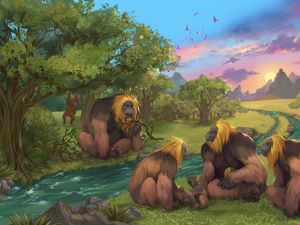Largest great ape that ever lived ‘became extinct because of climate change’
Gigantopithecus blacki stood 10ft tall and weighed up to 650lbs, or 46 stone.

An ancient species of great ape was likely to have been driven to extinction when climate change put their favourite fruits out of reach during dry seasons, scientists said on Wednesday.
The species Gigantopithecus blacki, which once lived in southern China, represents the largest great ape known to scientists, standing 10ft tall and weighing up to 650lbs, or 46 stone.
But its size may also have been a weakness.
“It’s just a massive animal – just really, really big,” said Renaud Joannes-Boyau, a researcher at Australia’s Southern Cross University and co-author of the study published in the journal Nature.

“When food starts to be scarce, it’s so big it can’t climb trees to explore new food sources.”
The giant apes, which probably resembled modern orangutans, survived for about two million years on the forested plains of China’s Guangxi region.
They ate vegetarian diets, munching on fruits and flowers in tropical forests, until the environment began to change.
The researchers analysed pollen and sediment samples preserved in Guangxi’s caves, as well as fossil teeth, to unravel how forests produced fewer fruits starting about 600,000 years ago, as the region experienced more dry seasons.
The giant apes did not vanish quickly, but likely became extinct some time between 215,000 and 295,000 years ago, the researchers found.

While smaller apes may have been able to climb trees to search for different food, the researchers’ analysis shows the giant apes ate more tree bark, reeds and other non-nutritious food.
“When the forest changed, there was not enough food preferred by the species,” said co-author Zhang Yingqi, of China’s Institute of Vertebrate Paleontology and Paleoanthropology.
Most of what scientists know about the extinct great apes comes from studying fossil teeth and four large lower jaw bones, all found in southern China. No complete skeletons have been found.
Between about two million and 22 million years ago, several dozen species of great apes inhabited Africa, Europe and Asia, fossil records show.
Today, only gorillas, chimpanzees, bonobos, orangutans and humans remain.
While the first humans emerged in Africa, scientists do not know on which continent the great ape family first arose, said Rick Potts, who directs the human origins programme at the Smithsonian’s National Museum of Natural History, in the US, and was not involved in the study.





